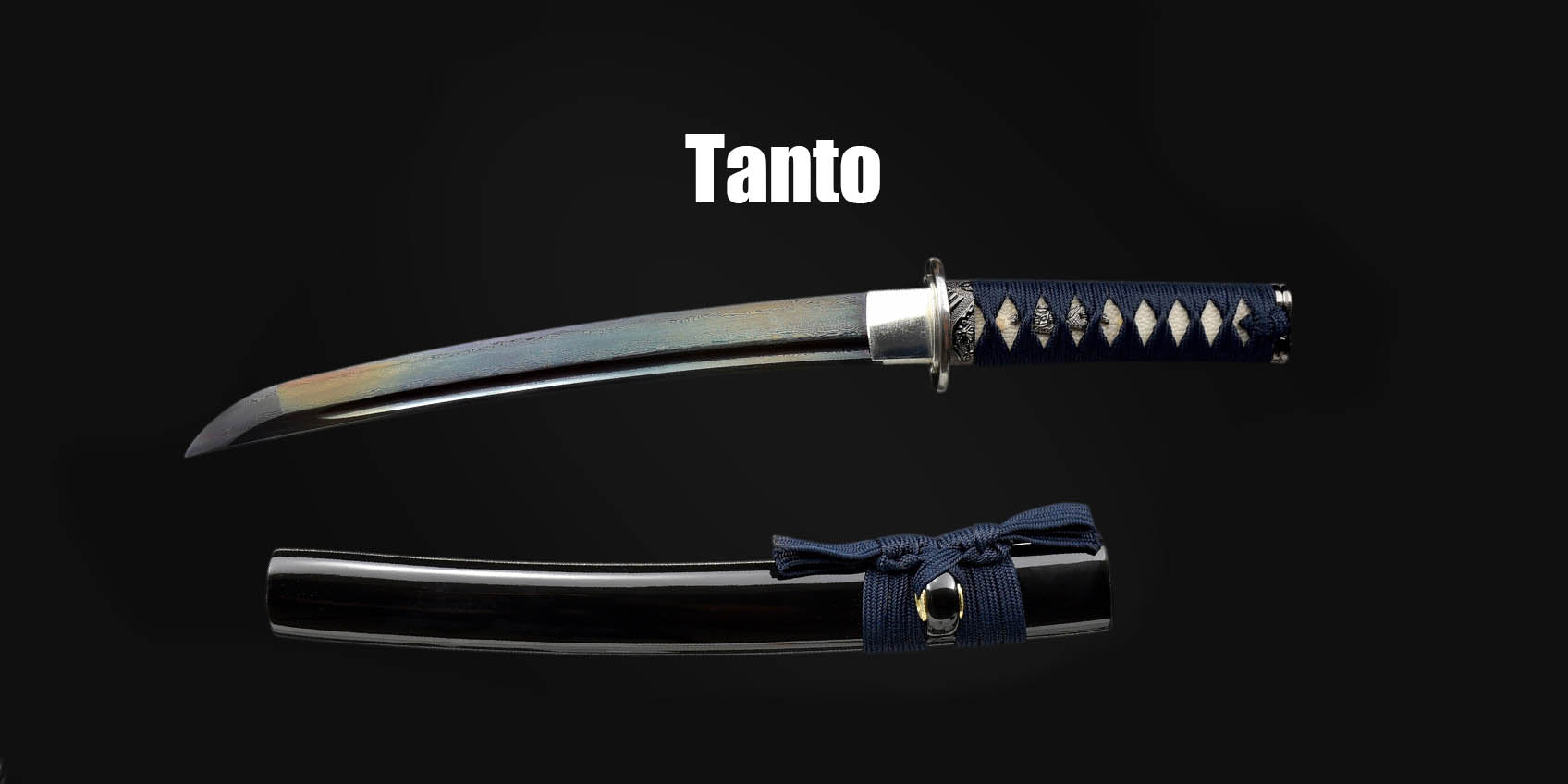How to Use a katana Sword — Guide to Tanto’s Combat Techniques

How to Use a Samurai Sword — A Comprehensive Guide to Tanto’s Combat Techniques and Cultural Value
When discussing how to use a katana sword, many people first think of the long and elegant Katana. However, among the various katana sword types, the short and sharp Tanto (dagger) is equally important. It is not only the samurai’s close-defense weapon but also a significant symbol of culture and ceremony. This article thoroughly analyzes the position, structure, usage, and cultural significance of the Tanto, guiding you to deeply understand this classic piece of Japanese blade weapons.
1. Introduction to Tanto: The Short-Blade Representative Among Different Katanas
The Tanto (dagger) originated in the Heian period, primarily designed for close combat and self-defense. Its blade length usually ranges between 15 to 30 cm, making it the shortest among all types of katanas.
In traditional Japanese sword classification, Tanto is an important part of the samurai sword name system, often counted as one of the “three swords of the samurai”:
-
Katana: Standard battle sword
-
Wakizashi: Auxiliary weapon, side sword
-
Tanto: Close-defense and ceremonial weapon
This also answers the common beginner question — what are the 3 samurai swords called?
2. Tanto’s Structure and Craftsmanship: The Exquisite Parts of a Katana
Although small in size, the Tanto has the same complex and refined structure as the Katana. Understanding the parts of a katana is crucial to recognizing the Tanto:
-
Blade (Ha): Made with various katana blade types, such as straight, curved, or flame-patterned hamon
-
Handle (Tsuka): Usually wrapped with ray skin and silk cords for a stable grip
-
Guard (Tsuba): Small but often decorated with intricate patterns or family crests
-
Scabbard (Saya): Crafted with lacquer techniques, showing aesthetic taste
Additionally, Tanto’s katana names and nicknames, like 'Muramasa,' 'Oni Fang,' and 'Fūma,' reflect the spirit of the samurai. They represent not only the swordsmith’s school but also the wearer’s identity, family, and beliefs.
Hand Forged Japanese Tanto Sword Short Sword Mini Katana Blue Blade Folded Steel Iron Tsuba Full Tang Sharp
3. Tactical Uses of Tanto: A Practical Guide on How to Use a Katana Sword
Among all different kinds of katanas, Tanto is the smallest and most portable, highly practical both on the battlefield and for personal defense. Its use emphasizes four key traits: 'speed,' 'accuracy,' 'concealment,' and 'thrust.' It is one of the most agile and covert weapons in the samurai blade system. Below are four typical uses of Tanto in combat.
1. Draw and Conceal Techniques: A Lethal First Strike
One of Tanto’s biggest advantages is its high concealability. It is usually hidden:
-
Inside kimono sleeves (called 'sodegiri' or sleeve knife)
-
Behind the obi belt
-
Within armor gaps (battlefield use)
This concealment makes the Tanto ideal for assassination, surprise attacks, and self-defense. Special Iaijutsu (quick-draw) techniques focus on the short sword, emphasizing striking vital points instantly from a zero-ready state.
Historically, famous ninja and spies used Tanto for silent killing. In training, these techniques are known as 'reverse hand draw' or 'concealed dagger assault,' a crucial part of learning how to use a katana sword.
2. Primarily Thrusting, Secondarily Slashing: Precise Close-Quarters Combat
Compared to the sweeping cuts of long swords like Katana or Tachi, Tanto is better suited for extremely close range with a focus on thrusting:
-
Targeting soft tissues like eyes, throat, and abdomen
-
Straight, short, and rigid blade suitable for penetrating armor gaps
-
Often used in close grappling or choking counterattacks
Tanto is widely used in reconnaissance, escort, night raids, and melee defense, especially effective in confined spaces like indoors or narrow corridors. Its agility and precision allow quick angle and direction control, providing fast and concentrated striking power in combat.
3. Complementing Hand-to-Hand Combat: Perfect Fusion of Grappling and Swordsmanship
Samurai were trained not only in swordsmanship but also in grappling arts like jujutsu and aikido. When enemies press close or engage in joint locks, the Tanto becomes a critical tool.
Common tactics include:
-
Escape from grabs: Blocking a chokehold with one hand, drawing Tanto with the other to stab the wrist
-
Belt counterattack: Quickly drawing Tanto from the belt when pinned on the ground
-
Two-hand release: When both hands are restrained, use body pressure to push Tanto out of the scabbard and guide it to the hand using elbows or thighs
These techniques highlight Tanto’s importance in close-quarters combat. Modern self-defense schools often train with Tanto replicas, including wooden or rubber daggers.
4. Ceremonial Use: A Spiritual Symbol in Samurai Culture
In Japanese culture, Tanto is not merely a weapon but also a spiritual carrier, playing vital ceremonial roles:
▸ The Designated Knife for Seppuku (Ritual Suicide)
Among samurai, Tanto was the standard blade for performing seppuku, a ritual to restore honor through self-disembowelment. This act was not cowardice but a profound expression of loyalty and repentance.
▸ Ceremonial Accessory
Female nobles and samurai wives often carried small Tanto called 'Kaiken,' symbolizing chastity and self-protection. It was a wedding gift representing 'guarding the body like a blade, guarding loyalty like life.'
▸ Symbol of Rank and Inheritance
Some families passed down ancestral Tanto as symbols of samurai lineage and status, awarding them to heirs or meritorious warriors to signify 'the family spirit never dies.'
Thus, Tanto carries immense cultural value and identity symbolism within katana styles.
4. Tanto’s Cultural Significance and Its Connection to Female Samurai
When exploring the relationship between samurai sword names and social identity, Tanto’s role among female warriors must be acknowledged. High-ranking samurai women often carried Tanto as a self-defense weapon symbolizing virtue and dignity.
This cultural phenomenon parallels the female naginata, a Japanese glaive favored by women for household defense with its own katana styles.
Today, many beginners train with wooden naginata for sale or wooden Tanto for safe practice, learning the unique advantages of naginata vs other weapons.
5. Tanto’s Forging Craftsmanship: A Miniature of How Katanas Are Made
Like the Katana, Tanto forging reflects the ancient Japanese artisan spirit:
-
Material selection: High-carbon steel like Tamahagane, repeatedly folded to form a tough blade
-
Clay tempering: Traditional clay tempering techniques create the unique hamon (temper line)
-
Polishing and assembly: Dozens of hand-polishing steps ensure sharpness and elegant lines
Even the smallest samurai sword, the Tanto embodies the full process of how are katanas made, a true 'concentrated work of art.'
6. Modern Value of Tanto: Both Collectible and Practical
Today, Tanto is not only used for combat training but also occupies a special place in samurai culture collections. Its small size, exquisite decoration, and profound meaning make it a favorite among collectors.
For beginners, learning Tanto techniques offers a gateway to understanding the entire types of samurai swords system, helping to master basic sword forms, body coordination, and drawing skills quickly.
7. Comparison with Other Weapons: Tanto’s Position Among Japanese Blade Weapons
| Weapon Name | Combat Range | Portability | Attack Style | Cultural Symbolism |
|---|---|---|---|---|
| Tanto | Close Range | ★★★★★ | Thrusting | Loyalty, Sacrifice |
| Katana | Mid-Range | ★★★☆☆ | Slashing | Honor, Samurai Spirit |
| Naginata | Mid-to-Long | ★★☆☆☆ | Slashing + Defense | Female Samurai, Home Defense |
| Japanese Glaive | Long Range | ★☆☆☆☆ | Sweeping Attacks | Military Use |
Clearly, Tanto holds unique advantages and symbolism among all Japanese blade weapons.
Conclusion: Tanto — Great Wisdom in a Small Blade
Although the Tanto is the smallest of the samurai sword names, it integrates artistry, combat practicality, and cultural spirit. As a core member of katana sword types, Tanto reveals concentrated power and hidden sharpness.
Whether you wish to study Japanese swordsmanship deeply or seek a unique collectible, the Tanto is an indispensable choice.










